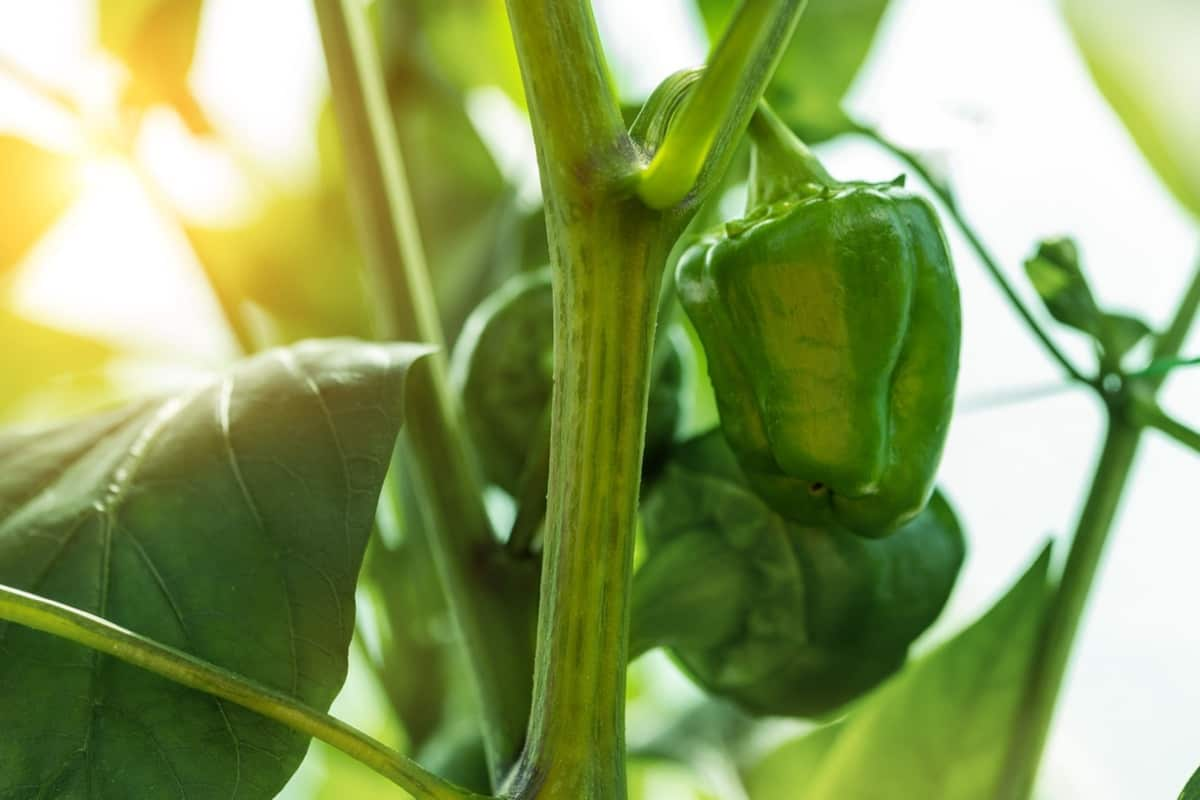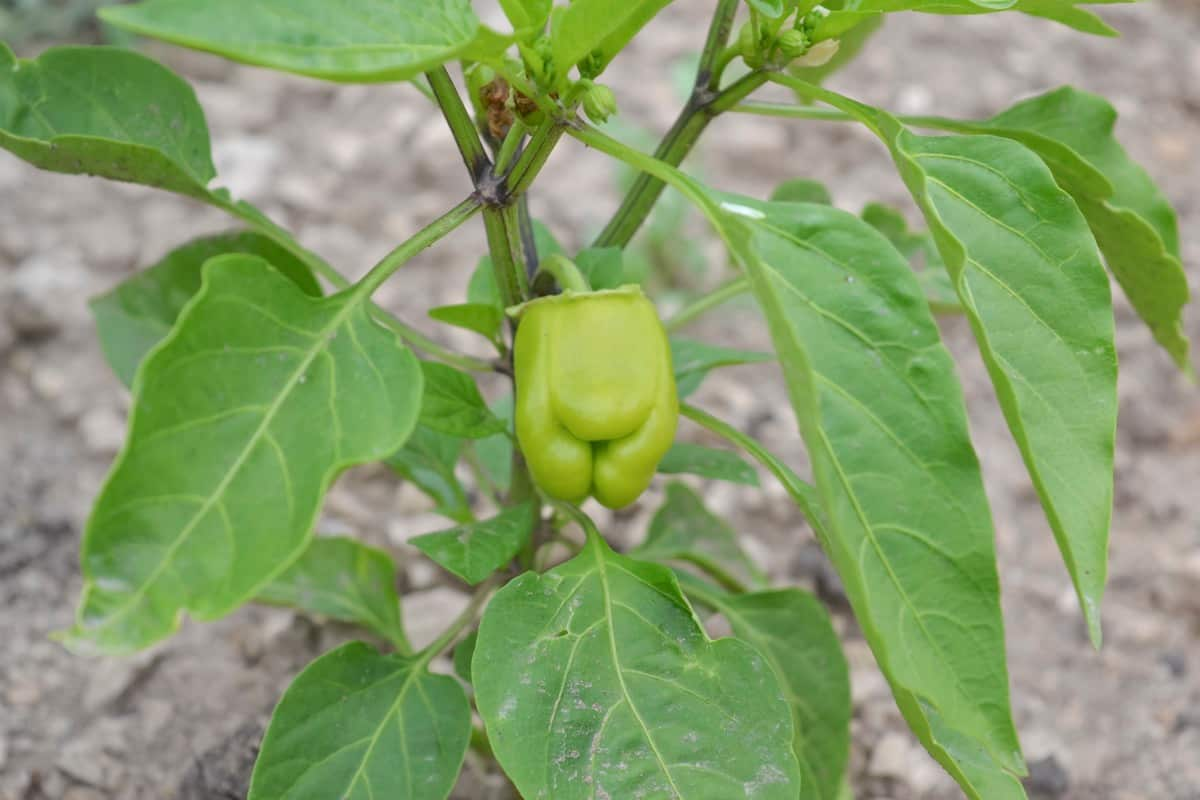One of the popular plants that many home gardeners cultivate is capsicum. Known for their vivid hues and distinctive taste, capsicum plants are a favorite for their versatility in various culinary uses. However, like any other plant, capsicum isn’t exempt from experiencing several problems.

Capsicum plants are susceptible to various issues, from yellowing leaves to attracting pests and wilting to not producing fruits. By understanding these problems, it’s possible to implement appropriate treatments and management solutions. This article will delve into the ten common problems garden-grown capsicum plants face and will provide practical solutions to keep them healthy and productive.
10 Common Problems With Garden-Grown Capsicum
Yellowing Leaves on Garden-grown Capsicum Plants
It’s disconcerting to see the lively green leaves of your capsicum plants turning yellow. Yellowing leaves often indicate nutrient deficiencies, specifically nitrogen, potassium, or magnesium. The easiest solution is to supplement the plant’s diet with a balanced fertilizer to help replenish these lacking nutrients.
Overwatering can also lead to yellow leaves as it can cause root rot, so ensure you’re not excessively watering your plants. Lastly, pests like aphids can cause yellow leaves as they suck the sap from the leaves, so checking for pest infestations and managing them promptly is essential.
Wilting Capsicum Plants in the Garden
When capsicum plants wilt, it’s often due to overwatering or underwatering. Adjusting your watering practices is the most straightforward solution. However, if the wilting persists despite correct watering, it could indicate a more serious problem such as root rot or Fusarium wilt. Fusarium wilt is a fungal disease that invades the plant’s vascular system, causing wilting. To treat capsicum disease effectively, remove infected plants to stop the disease from spreading and keep the soil in good health.
Capsicum Plants Not Producing Fruits
Capsicum plants not bearing fruit can be due to various reasons. It could be due to improper pollination, usually caused by a lack of pollinators or inappropriate weather conditions. You can hand-pollinate the flowers to improve the fruit set. A nutrient imbalance can also lead to fruitless plants. Ensure you provide your capsicum plants with a balanced diet of essential nutrients. Stress from extreme temperatures, either too hot or too cold, can cause this issue. Provide shade during intense heat and cover during cold snaps to maintain an optimal growing environment.
Capsicum Plants With Curled Leaves in the Garden
Leaf curl in capsicum plants is often a sign of stress from environmental conditions or pest attacks. Too much heat or cold, overwatering, or underwatering can stress the plant, leading to curled leaves. Adjusting these conditions will often correct the problem. Pest attacks, especially from aphids, thrips, and whiteflies, can also lead to curled leaves as these pests feed on the plant’s sap. Regularly check for pests and manage them using organic pesticides or introducing beneficial insects that prey on these pests.
Capsicum Plants With Discolored Spots on Leaves
Discolored spots on leaves are often a sign of fungal or bacterial diseases. For example, bacterial leaf spot manifests as tiny, water-soaked spots that eventually turn brown or black. Fungal diseases like Cercospora leaf spots produce grayish to brownish spots. Good garden hygiene, including regular pruning and removing fallen leaves, helps manage these diseases. Fungicides and bactericides can also be used, but they should be used sparingly and responsibly to prevent resistance development.
In case you missed it: How to Increase Female Flowers in Capsicum/Bell Pepper: Explained in 10 Simple Steps

Garden-grown Capsicum Plants With Stunted Growth
Stunted growth in capsicum plants is often due to nutrient deficiencies, particularly nitrogen, which is essential for plant growth. Adding a nitrogen-rich fertilizer can help solve this problem. However, it’s important to check for root-knot nematodes, tiny soil-dwelling pests that cause the roots to form knots, inhibiting nutrient uptake and stunted growth. If you detect these pests, they are best managed by crop rotation and using nematode-resistant plant varieties.
Capsicum Plants Attracting Pests in the Garden
Capsicum plants can attract various pests, including aphids, whiteflies, and spider mites. These pests can cause damage by feeding on the plant’s sap, leading to yellow leaves, curled leaves, and stunted growth. Regularly inspecting your plants for pests is an essential part of diseases of capsicum and their management. If you spot these pests, using organic pesticides or introducing beneficial insects that prey on these pests, such as ladybugs and lacewings, can be an effective solution.
Capsicum Plants With Blossom End Rot in the Garden
Blossom end rot is a common problem in capsicum plants where the bottom end of the fruit develops a leathery, dark patch. This problem occurs when there is a lack of calcium, usually caused by inconsistent watering methods that prevent the plant from absorbing calcium from the soil. Regular and even watering and a calcium-rich fertilizer can prevent and treat blossom end rot.
Garden-grown Capsicum Plants With Sunburned Fruits
Sunburned fruits are common in garden-grown capsicum plants, especially during the hot summer months. The fruits develop a white, bleached area, which can become sunken over time. This issue can be prevented by ensuring the plants have enough leaf cover to shield the fruits from the intense sun. Shading nets can be used during peak heat hours to protect the fruits if needed.
Capsicum Plants With Leaf Drop in the Garden
Leaf drop in capsicum plants can be alarming and is usually a sign of stress. Environmental stressors such as extreme temperatures, overwatering or underwatering, and nutrient deficiencies can cause this issue. Adjusting these conditions to suit the plant’s needs often helps solve the problem. Diseases, especially fungal ones, can also cause leaf drop. Regularly inspecting the plants for diseases and applying appropriate treatments is crucial for capsicum diseases and control.
Capsicum Plants with Cracked Fruits in the Garden
Cracked fruits are another common problem with capsicum plants. This can be a result of irregular watering or sudden temperature changes. When the plant receives water inconsistently, it can lead to rapid growth that the fruit’s skin cannot keep up with, resulting in cracks.
Similarly, a sudden increase in temperature can also cause the fruit to expand quickly and crack. To mitigate this, ensure that your capsicum plants are watered consistently and protect them from extreme temperature changes by providing shade or cover as needed. Using a mulch can also help maintain soil moisture and temperature, thus preventing the cracking of fruits.
In case you missed it: Hydroponic Capsicum/Bell Pepper Farming in a Greenhouse: Key Rules to Start from Scratch

Conclusion
Gardening is a rewarding endeavor but comes with its fair share of challenges, especially when dealing with capsicum plants. Whether dealing with yellowing leaves, pests, or non-productive plants, knowing the potential issues and having the right solutions at your disposal can significantly impact your gardening success.
It’s important to remember that the key to managing diseases of capsicum lies in regular monitoring, prompt action, and responsible use of any treatment. Doing so can ensure that your garden-grown capsicum plants thrive and provide a bountiful harvest.
- Feed Your Flock for Less: Top 10 Tips to Save on Chicken Feed
- Ultimate Guide to Ossabaw Island Hog: Breeding, Raising, Diet, and Care
- Hatching Answers: The Top 10 Reasons Your Chickens Aren’t Laying Eggs
- Eggs and Economics: Breaking Down the Cost of Raising Backyard Chickens
- Defend Your Greens: Proven Methods to Keep Iguanas Out of Your Garden
- Ultimate Guide to Cinnamon Queen Chicken: A Comprehensive Guide for Beginners
- Ultimate Guide to California Tan Chicken: Breeding, Raising, Diet, Egg-Production and Care
- Ultimate Guide to Marsh Daisy Chicken: Breeding, Raising, Diet, and Care
- 10 Types of Chicken Farming Businesses You Can Start for Profits